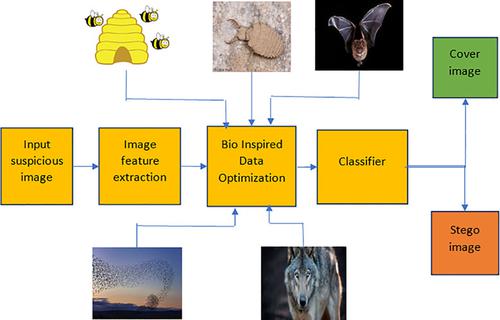当前位置:
X-MOL 学术
›
WIREs Data Mining Knowl. Discov.
›
论文详情
Our official English website, www.x-mol.net, welcomes your feedback! (Note: you will need to create a separate account there.)
Critical review of bio-inspired data optimization techniques: An image steganalysis perspective
WIREs Data Mining and Knowledge Discovery ( IF 7.8 ) Pub Date : 2022-05-03 , DOI: 10.1002/widm.1460 Anita Christaline Johnvictor 1 , Austin Joe Amalanathan 2 , Ramya Meghana Pariti Venkata 1 , Nishtha Jethi 1
WIREs Data Mining and Knowledge Discovery ( IF 7.8 ) Pub Date : 2022-05-03 , DOI: 10.1002/widm.1460 Anita Christaline Johnvictor 1 , Austin Joe Amalanathan 2 , Ramya Meghana Pariti Venkata 1 , Nishtha Jethi 1
Affiliation

|
Image steganalysis involves the discovery of secret information embedded in an image. The common method is blind image steganalysis, which is a two-class classification problem. Blind steganalysis extracts all possible feature variations in an image due to embedding, select the most appropriate feature data, and then classifies the image. The dimensionality of the extracted image features are high and demand data reduction to identify the most relevant features and to aid accurate classification of an image. The classification is under two classes namely, clean (cover) image and stego (image with embedded secret data) image. Since the classification accuracy depends on selection of most appropriate features, opting for the best data reduction or data optimization algorithms becomes a prime requisite. Research shows that most of the statistical optimization techniques converge to local minima and lead to less classification accuracy as compared to bio-inspired methods. Bio-inspired optimization methods obtain improved classification accuracy by reducing the high-dimensional image features. These methods start with an initial population and then optimize them in steps till a global optimal point is reached. Examples of such methods include Ant Lion Optimization (ALO), Fire Fly Algorithm (FFA), and literature shows around 54 such algorithms. Bio-inspired optimization has been applied in various fields of design optimization and is novel to image steganalysis. This article analyses the various bio-inspired optimization techniques and their accuracy in image steganalysis pertaining to the discovery of embedded information in both JPEG and spatial domain steganalysis.
中文翻译:

仿生数据优化技术的批判性回顾:图像隐写分析视角
图像隐写分析涉及发现嵌入图像中的秘密信息。常用的方法是盲图像隐写分析,这是一个二分类问题。盲隐写分析提取图像中由于嵌入导致的所有可能的特征变化,选择最合适的特征数据,然后对图像进行分类。提取的图像特征的维数很高,需要减少数据以识别最相关的特征并帮助对图像进行准确分类。分类分为两类,即干净(覆盖)图像和隐秘(嵌入秘密数据的图像)图像。由于分类准确性取决于选择最合适的特征,因此选择最佳数据缩减或数据优化算法成为首要条件。研究表明,与仿生方法相比,大多数统计优化技术收敛到局部最小值并导致分类精度降低。仿生优化方法通过减少高维图像特征来提高分类精度。这些方法从初始种群开始,然后逐步优化它们,直到达到全局最优点。此类方法的示例包括蚁狮优化 (ALO)、萤火虫算法 (FFA),文献显示大约 54 种此类算法。仿生优化已应用于设计优化的各个领域,对图像隐写分析具有新颖性。
更新日期:2022-05-03
中文翻译:

仿生数据优化技术的批判性回顾:图像隐写分析视角
图像隐写分析涉及发现嵌入图像中的秘密信息。常用的方法是盲图像隐写分析,这是一个二分类问题。盲隐写分析提取图像中由于嵌入导致的所有可能的特征变化,选择最合适的特征数据,然后对图像进行分类。提取的图像特征的维数很高,需要减少数据以识别最相关的特征并帮助对图像进行准确分类。分类分为两类,即干净(覆盖)图像和隐秘(嵌入秘密数据的图像)图像。由于分类准确性取决于选择最合适的特征,因此选择最佳数据缩减或数据优化算法成为首要条件。研究表明,与仿生方法相比,大多数统计优化技术收敛到局部最小值并导致分类精度降低。仿生优化方法通过减少高维图像特征来提高分类精度。这些方法从初始种群开始,然后逐步优化它们,直到达到全局最优点。此类方法的示例包括蚁狮优化 (ALO)、萤火虫算法 (FFA),文献显示大约 54 种此类算法。仿生优化已应用于设计优化的各个领域,对图像隐写分析具有新颖性。































 京公网安备 11010802027423号
京公网安备 11010802027423号